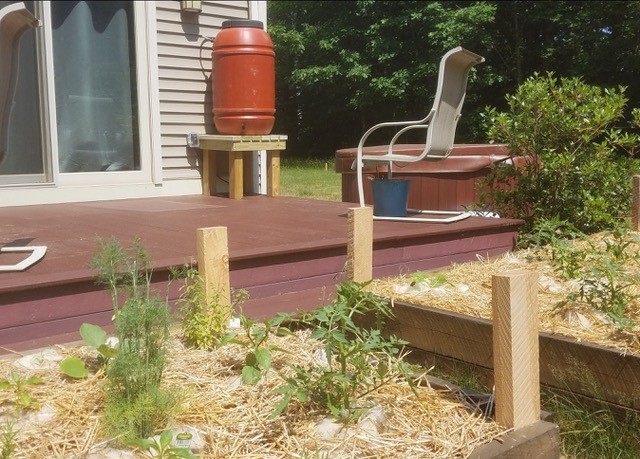By Judith Saum, NRS ’19

Who would have imagined when I moved to New Hampshire from the drought-stressed landscape of my desert home in Nevada three years ago that I would encounter times of serious rainfall shortage here? After living for more than four decades in a place that averages only 7 inches of precipitation a year, I dreamed that my NH yard and garden would always be vibrant and green given the 45 annual inches of rain that reportedly falls here.
That fantasy soon faded! By mid-summer, the rain stopped for several weeks, my flower gardens wilted, and homeowners in the area were cautioned against lawn-watering lest their wells go dry. Indeed, I was having flashbacks to Nevada that I had not expected to experience living in NH.
Soon after my arrival, I decided to embark on a project of transforming much of the two acres of manicured lawn on my property into a more naturalized landscape that would encourage birds and wildlife. The path for achieving that goal led me to the 2019 Natural Resources Stewards class and so began my education about how to re-wild my yard.
The class assignment that featured analyzing the characteristics of your own property provided some valuable insights. I was fascinated to learn that my flat piece of land had been used since the early 1800s as a hay field to grow forage for farm animals. Topographic maps show it as the highest point in relation to the surrounding terrain, suggesting that any precipitation that does not sink in runs off in multiple directions to the nearby river. An old geologic survey describes the soil as “alluvial, loamy sand”. I confirmed (by digging a soil profile) that this sand extends uniformly to a depth of at least 3 feet and is poor in organic matter (not surprising given the historic use). I soon figured out that keeping plants sufficiently hydrated on this sand heap was going to be my main challenge!
Gratefully I got some good ideas in class from Soak Up the Rain NH, and decided to install two 55-gallon rain barrels on our roof downspouts to support the garden through summer dry spells. To regenerate the thirsty soil plus harbor overwintering insects that attract birds, I started leaving dead leaves on the garden beds or chopping them up with my mulching mower to spread on areas I wanted to keep as lawn. I ordered a truckload of wood chip to mulch and retain moisture around trees and shrubs. I installed an outdoor shower that directed gray water to a small, nearby garden bed.
Yet I was not prepared for the severe, extended drought that transpired last summer. While the rain barrel water was helpful in keeping the gardens near the house alive, the supply was insufficient to irrigate parts of the lawn that I had overseeded with Dutch clover, and after a vigorous start, it all died out. Nor was there enough rainwater to irrigate the tree seedlings from the State Nursery and several of them, including most of the bayberry and a couple of white spruce, succumbed. I had heeded warnings that wells were at risk and watered only sparingly from mine.
In January, I was motivated by last summer’s experience to sign up for a UNH Extension program entitled Dealing with Drought: A Workshop for Landscapers, Gardeners and Property Managers. The virtual class was a forum for exploring landscaping practices to create resilience given the more frequent and serious drought events that are predicted related to climate change. Some startling background about drought impacts on plants was detailed, including the fact that trees close their leaf stomates to conserve moisture during periods of insufficiency, resulting in reduced photosynthesis, decreased growth, and root structure damage. It can take up to 3 years for a tree to recover from these negative effects after suffering the severe kind of drought we had last year.
There were many constructive suggestions about methods for coping with drought, such as installation of a drip system to maximize efficient water use. One message that resonated with me was the need to understand your soil type’s moisture-holding capability as a guide for knowing how often to water plants and trees. I found out that the recommended watering schedule for tree seedlings growing in loamy sand like mine is every 7 days during dry spells. To support this effort, I am installing four additional rain barrels this spring to provide water for the new birch and juneberry seedlings ordered from the state. Utilization of a cistern for increased water storage capacity was also referenced, something which I am considering doing as part of a personal, long-range, drought resilience plan.
The workshop included valuable instruction on plant selection, and I learned that there are drought-tolerant species that can go for 2 to 4 weeks without water. Yet I admit to some ambivalence when it comes to this topic because I long to grow some moisture-dependent plants like spice bush and Joe Pye weed. So, for me one nagging question remains, “Do I love these plants enough to want to deal with keeping them regularly watered when there is no rain”? I have not fully answered that one yet.
To comment or engage in further discussion about this topic, please contact me at judithsaum@gmail.com.
